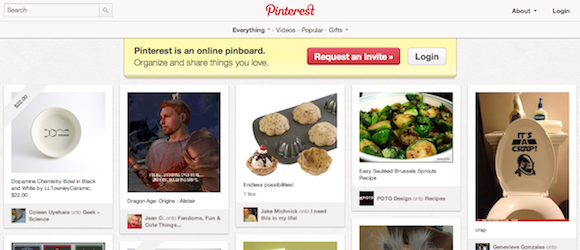Pinterest: A “Shocking” Example of Women Using the Internet
the internet is serious business

Last week, the media discovered Pinterest. Mashable reported that it drove more traffic than Google+ last month and was on par to match Twitter in click-through rates. Soon after, tech analysts debated whether Pinterest would be the next Groupon, soon be usurped by myriad copycat sites.
However, another topic started to emerge that should be far more troubling to social media users. Tech journalists covering the site started using phrases like “female-centric” and “catnip for women,” in their articles.
It’s a curious choice of words and not just because men founded the site.
Founder Ben Silbermann told HGTV that he created the site because, “As a kid, I loved collecting. I collected everything from insects to stamps to books. I’ve always thought that the things you collect — whether it’s the furniture in your home or the music on your iPod — says a lot about who you are. I thought it would be great to bring that entire experience online and help connect people who have common interests.”
His description is decidedly gender-neutral and easy to understand: a site to collect your interests. And yet, when tech blog Gizmodo put together its write-up on the site, the lead read, “Quick! Name the most perplexing social site you can think of. If you are a dude, it is probably Pinterest.”
Even MSN Money framed the conversation in terms of male v. female users: “Even though the site may be dominated by women’s interests, think of it this way: It’s essentially a guide telling men everywhere exactly what women want.”
Neither of these statements is a problem on its face. It’s true that women use the site in large numbers. In fact, Forbes is reporting that 70 percent of the user base is women. However, it should be no shock to seasoned tech reporters and talking heads that women use the Internet.
In fact, the core problem is the idea that somehow the site has less value or is inherently confusing because women are using it. Ask yourself these questions:
- Was Reddit’s rise covered by tech bloggers and journalists with aside paragraphs like: “If you want to know what men like, go check out Reddit!”?
- Did snarky bloggers make pie-charts like this one when Tumblr was growing that pointed to gender stereotypes about men?
- Did tech analysts write blog posts about the “manliness” of any given tech startup?
- Did tech experts ever go out of their way to explain the appeal of a new social media site to women by stressing that it really wasn’t overtly manly?
If you answered “no” to all these questions, I’m not surprised.
Most social media experts agree that the way to build a user base is to start with thought-leaders in relevant fields and give them access to share what the site has to offer. When Silbermann and his team first launched Pinterest, they gave invitations to all the ALT Summit attendees to use the site. For who don’t know, ALT Summit’s core audience is largely women and creative types. The basic visual makeup of the site and its collection mechanism appealed to these types of users and soon, these women started talking about the site in their respective circles.
However, it wasn’t until Pinterest partnered with blogger SF Girl By Bay in May of 2010 on a project called “Pin It Forward”, that the site to truly took off with women. The project brought together 300 high-profile design bloggers (also primarily women) to create daily inspiration pinboards on the theme “What Home Means to Us”. This collaboration gave Pinterest the passionate audience it needed to survive in the long-term.
All of this aside, no good startup will last and make its way to the general public without users who come back again and again. The users must find the site beneficial to their lives, especially in a time where there is a new startup every day of the week.
The true reason why users are sticking with Pinterest and driving traffic in record numbers is because it’s beautiful and it’s useful. Sure, women are posting photos of their wedding dresses and baby outfits, but they’re also using it to post photos of their dogs, plan vacations and save creative tech accessories.
If a user can’t find a purpose for it, then they shouldn’t use it, regardless of gender. In the meantime, we should be urging tech writers to broaden their minds. Yes, women are using the Internet. And we’re driving more traffic than ever before.
Elizabeth Giorgi is a writer and filmmaker from Minneapolis. She blogs about mixing life as a nerd with her career at beinggeekchic.com. In 2010, she was nominated for a Webby and won an Emmy for Science of Watchmen. Follow her on Twitter: @lizgiorgi
Have a tip we should know? tips@themarysue.com